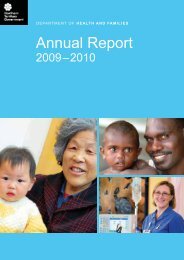PCD Strategy Evaluation 2007.pdf - NT Health Digital Library ...
PCD Strategy Evaluation 2007.pdf - NT Health Digital Library ...
PCD Strategy Evaluation 2007.pdf - NT Health Digital Library ...
You also want an ePaper? Increase the reach of your titles
YUMPU automatically turns print PDFs into web optimized ePapers that Google loves.
5.3 Underlying determinants of health5.3.1 Maternal and childhood educationRefer to section 3.2 of this report for information on educational attainment.5.3.2 Alleviate PovertyThe alleviation of poverty is the most important factor in the prevention of chronic disease as itaffects levels of education, access to food and shelter and our basic human needs. ManyIndigenous Australians live below the poverty line, receiving a mean income that is 59 per cent ofother Australians (51) . In remote areas the food budget can represent 56-89 per cent of the totalIndigenous household income, compared with the national average of 18 per cent. In 2006, <strong>NT</strong>Indigenous households continue to receive only 59 per cent of income to non-indigenoushouseholds (5) . These factors affect every aspect of Indigenous lives including their ability to livein safe housing and to buy sufficient good quality food for their families (93) . It is however beyondthe scope of this evaluation to provide evidence of this in the <strong>NT</strong> community.5.3.3 Promote ‘sense of control’ and mental well-being (KRA)Data on this has been collected in the DRUID study in urban Indigenous people in Darwin in2004. Trend data is not available. The <strong>NT</strong>DH&CS conducted a <strong>Health</strong> and Well-being Survey inthe Non-Indigenous population of the <strong>NT</strong> in December 2000 (94) . In this survey respondents wereasked about their perceived control of life events. Overall, 5.5 per cent of the urban population,and 6.1 per cent of the rural population felt a lack of control in their life often or always. 12.8 percent of respondents reported being psychologically distressed using the Kessler 10 score. Trenddata is not available for this study.5.4 Lifestyle modification5.4.1 Smoking cessation and prevention programs (BB)Smoking is the single most important modifiable cause of preventable disease, disability, andpremature death in the <strong>NT</strong>. In 2002, 40 per cent of the <strong>NT</strong> Indigenous population between 15and 24 year olds were current daily smokers, compared with 30 per cent of this age group in thenon-Indigenous population. This equates nationally with this population group. In 2006, AIHWChapter 5: Key Result Areas – <strong>Evaluation</strong> of the <strong>NT</strong> Preventable Chronic Disease <strong>Strategy</strong> 2007 84
















